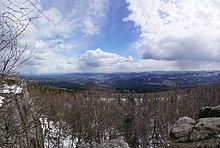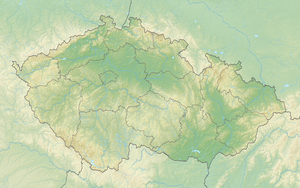Děčínský Sněžník
| Děčínský Sněžník | ||
|---|---|---|
|
View from Děčín ( Tetschen ) over the Elbe westwards to Děčínský Sněžník (High Snow Mountain) |
||
| height | 722.8 m nm | |
| location | near Jílové ( Eulau ); Děčín district , Ústecký kraj region ( Czech Republic ) | |
| Mountains | Elbe Sandstone Mountains | |
| Dominance | 12.3 km → Jeleni ( 734 m , Czech Ore Mountains ) | |
| Notch height | 153 m ↓ immediately north of Tisá | |
| Coordinates | 50 ° 47 '44 " N , 14 ° 6' 25" E | |
|
|
||
| Type | Table Mountain | |
| rock | Sandstone | |
| particularities | - highest mountain in the Elbe Sandstone Mountains - Schneebergturm ( AT ) |
|


The Děčínský Sněžník (German: Hoher Schneeberg , also Tetschner Schneeberg ) near Jílové (Eulau) in the Czech region of Ústecký kraj is the highest mountain in the Elbe Sandstone Mountains at 722.8 m nm .
Typical of the mountain are the steep, barely indented rock faces on its flanks made of solid sandstone from the Turon . The Schneebergturm observation tower has stood on it since 1864 . The dense spruce forest that once existed on the flat summit plateau was completely destroyed in the 1980s by the effects of sulfur dioxide .
Geographical location
The Děčínský Sněžník is located in the left part of the Elbe Sandstone Mountains. Its peak rises about 8 km west-northwest of the at the same town of Decin (Decin) . On the southwest side of the mountain is the village Sněžník ( Snow Mountain ). The town of Jílové ( Eulau ) is located below the steep southern slope at the Labe tributary Jílovský potok (Eulabach ) and a little further east Bynov as a district of Děčín. To the north runs the old country road between Pirna and Děčín (formerly Reichsstrasse 177 ), which has been interrupted at the nearby border since 1945. Parts of the Elbe Sandstone Protected Landscape Area are located on the mountain .
history
When the state was to be re-measured in the middle of the 19th century in connection with the Central European degree measurement in Bohemia and in the Kingdom of Saxony , Count Franz Anton von Thun and Hohenstein had the still existing stone observation tower built in 1864 according to plans by the Saxon chief architect Karl Moritz Haenel . From 1866 it served as first order station No. 8 Schneeberg of the Royal Saxon Triangulation . For this purpose, there was a stone surveying point on the tower's viewing platform that no longer exists.
In 1865 a bar opened for the first time at the foot of the tower. A few years later, a mountain hut was built in the Swiss style, which was then just in fashion . In the following years the mountain developed into a popular destination for hikers and day trippers. In 1936 a television signal could be received on the observation tower for the first time in Bohemia, which was broadcast for the Summer Olympics in Berlin . With a self-made device, Professor Matthias Färber from Bodenbach was able to hear the sound of the program.
After the German population was expelled from Bohemia after 1945, the buildings on the mountain gradually fell into disrepair. The mine was still in use until the 1970s. In 1986 it was demolished. The condition of the observation tower also deteriorated steadily, so that it was closed at the end of the 1980s. Only after the political change in 1989 did the decline stop. In 1992 the tower , which is now under monument protection , was extensively renovated and a few years later a new mountain inn was built on the historic site.
Geology and mining
The contact zone of the Bohemian part of the Elbe Sandstone Mountains is marked by the outflowing Central Saxon fault . It is also the border between the gneiss area of the Eastern Ore Mountains and the sandstone of Bohemian Switzerland. In the Egergraben , which runs south of the entire Ore Mountains, the main section of the tectonically induced volcanism lay in the period between 42 and 18 Ma BP (millions of years before), with the beginning of which the uplift of the Ore Mountains Pultscholle began. While the Ore Mountains were finally lifted 600 to 800 meters ago about 31 to 26 Ma BP (Middle Oligocene ), the uplift of the Eastern Ore Mountains only came to an end in the Lower Miocene and the neighboring sandstone deposits only experienced this vertical transport about 14 to 10 Ma BP (Middle Miocene). Therefore, this area reaches the greatest heights of the Elbe Sandstone Mountains with the Hohe Schneeberg as the highest point.
The rock of the tabular mountain body is a medium to coarse-grained quartz sandstone of the Jizerá formation from the middle to upper Turonian . At the foot of its steep walls there are large amounts of sand and loose blocks that have their origin in diluvial erosion processes.
Below the summit plateau on the southern slope of the Hohe Schneeberg in the area of the “lower wall” there is a fluorite that was discovered in 1906 by geologist Josef Emanuel Hibsch . However, mining of the deposit only started after the Second World War in the course of industrial development in Czechoslovakia . Between 1955 and 1957, the deposit was explored and the first trial extraction. From 1968 onwards, dismantling began. The deposit was developed through several tunnels , the extraction itself took place on 8 levels . The mine site covered a total area of around 250 hectares, the length of the tunnels created was around 21 kilometers. When driving the tunnels, the miners came across a series of pseudo karst caves that were up to 150 m long, 10 m wide and 30 m high. The formation of these caves goes back to the formation of gaps in the sandstone in connection with the elevation of the Ore Mountains in the Tertiary . Hydrothermal solutions penetrated the large fissures and crystallized them with fluorite. In 1993 the mine at Schneeberg was closed for economic reasons. The total extraction of rock up to then amounted to around 200,000 tons, with extraction rates of up to 12,000 tons being achieved in individual years. The extracted rock usually had a fluorite content of over 90%. After the pit was closed, the access to the pit was kept. Only the mouth hole to tunnel no. 4 remained. It forms the (non-public) access to an approximately 1 km long section of tunnels that opens up several of the pseudokarst caves and has been protected as a natural monument since 1999.
Schneeberg tower
The Schneebergturm observation tower has stood on the Hohe Schneeberg since 1864 . The view from there is certainly one of the most beautiful and impressive in Bohemia . The view wanders in the northeast over Saxon and Bohemian Switzerland , in the east over the Lusatian Mountains and Jeschkenkamm , in the south over the hilltop landscape of the Bohemian Central Mountains and in the west over the ridge plateau of the Eastern Ore Mountains . In the distance, the ridge of the Giant Mountains can also be seen in the east . The Dresden view ( Drážd'anská vyhlídka ) on the north side of the mountain plateau is famous .
Routes to the summit
- You can get to the Hohe Schneeberg from Děčín via the red marked European long-distance hiking trail E3 .
- The municipality of Rosenthal-Bielatal is also a good starting point for visitors from Germany . From there Rosenthal of the way across the border crossing leads Owls Thor and about the village Sněžník ( Snow Mountain ) to the summit.
The mountain climbing
Děčínský Sněžník is a climbing area , mainly for bouldering .
See also
Web links
- Tower and inn on the Hohe Schneeberg , on boehmische-schweiz.de
Individual evidence
- ↑ The mountain is a northeast branch of the Rudný vrch ( Obere Winterleite , 796 m ) west of Telnice
- ↑ dominance according to TK 25; Prominence (notch at approx. 570 m) via Elevation Contours in Google Maps (as there is no TK 25 from the notch) - therefore the actual notch height may differ by a few meters.
- ↑ W. Pälchen, H. Walter (ed.): Geology of Saxony. Geological structure and history of development . Stuttgart 2008, ISBN 978-3-510-65239-6 , pp. 476-477.
- ↑ J. Valecka et al .: Geologická mapa ČR. List 02-23 Děčín. Český geologický ústav, 1992 (call numbers 7, 37).
- ↑ Richard Pokorný: Fluoritové jeskyně v severních Čechách ( Memento of the original dated February 2, 2014 in the Internet Archive ) Info: The archive link was inserted automatically and has not yet been checked. Please check the original and archive link according to the instructions and then remove this notice. (PDF; 705.7 kB).
- ↑ Name and panoramic view , on www.skalnimesta.cz
- ↑ Děčínský sněžník. Bouldering. Průvodce. Retrieved September 13, 2017 (Czech).
- ↑ Article Bouldering am Schneeberg, Czech Republic in the magazine Klettern, accessed on October 9, 2017



